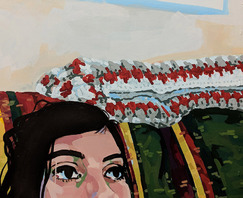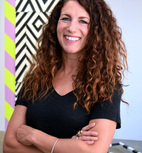
Academics . Painting . Courses
Painting Courses
Image + Form II: Reproducibility
Course No. VAT 202 Credits: 3.0
Though we often think of artworks as unique, this is not an intrinsic or inherent quality of the work itself, but the result of the choice of media. Consequently, since the Renaissance and the advent of Printmaking, the printing press, and bronze casting, multiplicity and reproduction have been a part of Western culture. The machine age, photo-reproduction, lithography, industrial standardization, modularity, fabrication, and multiplicity became part of artistic practice. Prints, posters, ready-mades, objects, books, comics, and designed utilitarian objects editions, multiples, modules, and reproductions are now a significant aspect of contemporary art making which abandons the notion of the unique work. Making works of this kind requires the artist to take into consideration how the act of reproduction, or replication constitutes part of their workâs form and content. 3 credits.
Collage + Assemblage
Course No. VAT 212 Credits: 3.0
Collage and Assemblage are among the most radical innovations of the early 20th century and these forms remain relevant today as sources for innovation and experimentation. Each of these forms acknowledges the fracture of contemporary life and the ongoing need for new means of expression. This course will explore the relationship between collage and assemblage and various disciplines within the visual arts including Painting, Print, and Drawing. Students will learn to discern the significantly different effects and content of the wide range of strategies these approaches encompass. Through classroom discussion, lectures, readings, critiques and studio work students will explore the possibilities available through collage and assemblage. Emphasis will be given to the historical and contemporary studio practices associated with collage and assemblage. This course is open to all students from all majors. Students will be encouraged to apply their area of expertise to the studio work. 3 credits.
Installation + Constructed Objects
Course No. VAT 226 Credits: 3.0
This course is a special topic course designed to cover the design, construction and lighting of installations, stage sets, and performance spaces. Students will investigate contemporary applications and approaches to subjects specifically composed for the camera and document installations that exist outside of the studio environment, with an emphasis on the genreâs relationship to historical and contemporary theatre. Workshops include cameras, studio lighting, basic electricity and carpentry, with an emphasis on scenery design. Students will plan and create small-scale models of stage designs; scale up these designs, and document their design. This course is designed for the Photography major and any students working in installation or Industrial Design but is open to all majors. 3 credits.
Watercolor Plus
Course No. VAT 240 Credits: 3.0
This course explores the different materials and processes used in various water-based media such as acrylic, gouache, watercolor, ink, and other natural substances that can be used to make colors/washes. Various historical models will be examined such as Chinese scroll painting and watercolor from the Song dynasty to Renaissance architecture and figure studies to post-impressionist use of color and mark which will put contemporary use of water-based media into focus. The work of artists as varied as William Blake, Vincent Van Gogh, Charles Burchfield and Paul Klee to more recent artists such as Francesco Clemente, Marlene Dumas, Amy Cutler, Shazia Sikander and Franz Ackermann, will be examined within the context of the studentâs personal practice. This course is open to all students with the prerequisite of PTG221 or PTG232 or with the permission of the instructor. 3 credits.
Silkscreen
Course No. VAT 270-370-470 Credits: 3.0
Students will investigate surface, mark, and materiality from both a technical and conceptual point of view. The silkscreen can accept a wide variety of printing substances (pigments, inks, dyes, mud, talc, honey, etcetera...), and can be applied to an equally diverse range of surfaces. Lectures, readings, and critiques will help students understand the historical role of screenprint and how it relates to their own work. Open elective for all students above the freshman level. 3 credits.
Aesthetics, Style + Content
Course No. VAT 300 Credits: 3.0
Aesthetics Style and Content focuses primarily, on the acquisition of creative and technical skills in the context of the development of original ideas and personal style. Studio work will consist of the practical exploration of the relationship between formal, technical, aesthetic, and stylistic issues relative to the personal, and thematic subjects of the students own choosing. Relative to this, in the seminar portion of the course the students are given critical, theoretical, philosophical background to issues surrounding the subjects of style, aesthetics and content. In the studio the students are encouraged to think of their work as an integrative whole consisting of these various components. In this context they are required to engage in independent critical research on topics relevant to their work. Their research takes the form of both archival and studio work and is presented in both visual and written form. This course is required for all senior students in Visual Arts. 3 credits.
Critical Conversations â" Art in Practice
Course No. VAT 316 Credits: 3.0
In this studio/seminar class, each student will delve into the work of one contemporary artist. Students will select their research subject from a prominent contemporary collection, experiencing the work in-person. Through a balance of artmaking and research, students will investigate: How does the artist Iâve selected create their work? As an emerging artist, what can I learn from this accomplished artistâs approach to artmaking and their professional practice? How does the broader culture view this artistâs work? How can my day-to-day studio practice reflect this learning? Students will sharpen their critical inquiry skills through material investigations, research of artistsâ writings, and reflections on historyâs impact on the accomplished artistâs ideas. The semesterâs work will culminate in a final public, professional presentation of the studentsâ studio work and research. Open to all students. 3 credits.
Hybrid Approaches to Drawing + Painting: Digital Media
Course No. VAT 327 Credits: 3.0
Emphasis is on integrating digital processes into studio practice and production. The class deals with a spectrum of digital applications in a studio practice including straightforward digital output, using digital as a means of producing source material as well as actually integrating digital processes into the production of work. Through slide presentations, viewing actual work, discussions and readings, students will be introduced to the place of the digital in contemporary studio practice. In studio production, students will use varied media and subjects, both traditional and non-traditional, to further develop their analytical and expressive means in their creative practice. Students are encouraged to draw from many disciplines incorporating them in the projects presented to the class for group critiques. Open to all students â" required of Printmaking and Drawing juniors. 3 credits.
Meet Your Faculty view all
Natalie Lanese
Adjunct Faculty
Natalie Lanese’s work is recognized for its punchy color palette and layered patterns. She makes paintin...more
Featured Student Work view all

Our connections are your connections.
While at CIA, you'll learn from the masters through our rigorous, world-class curriculum and connect with working professionals to begin your career.


